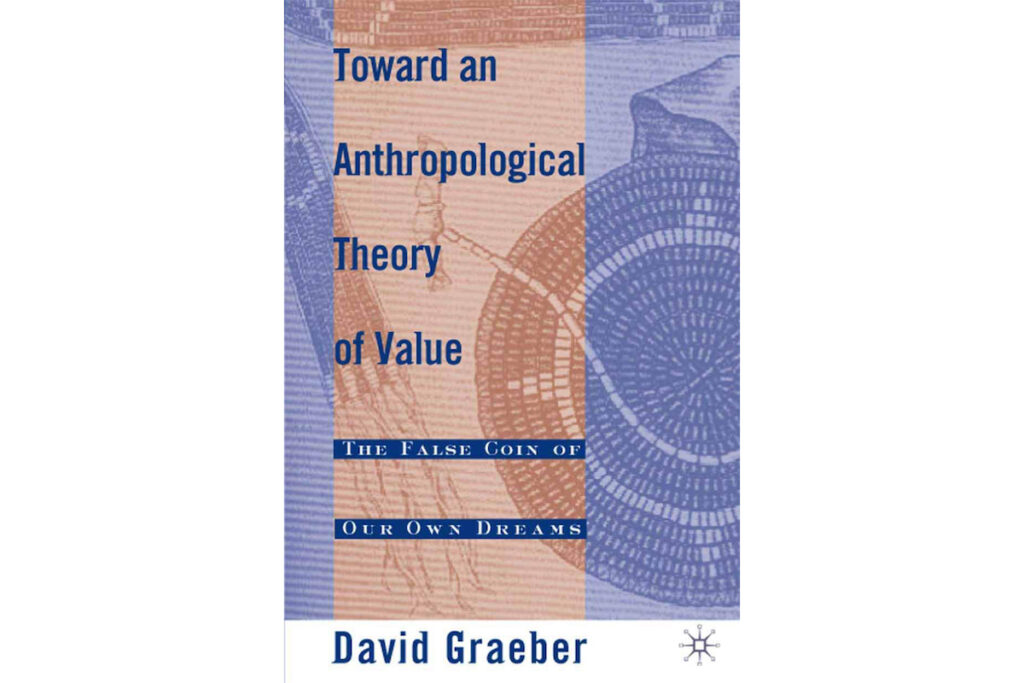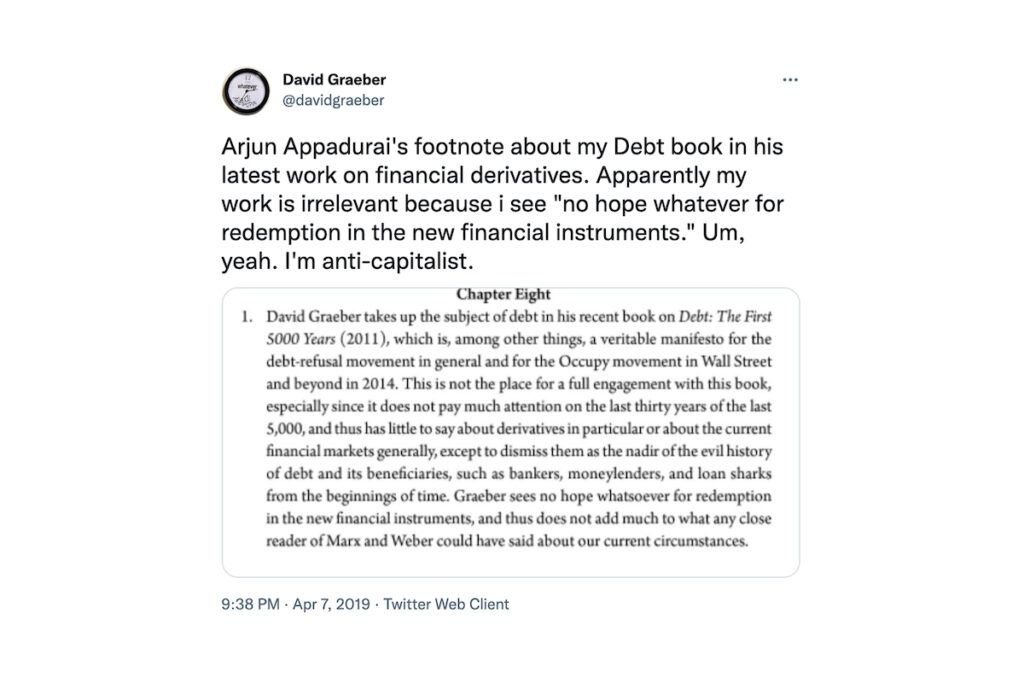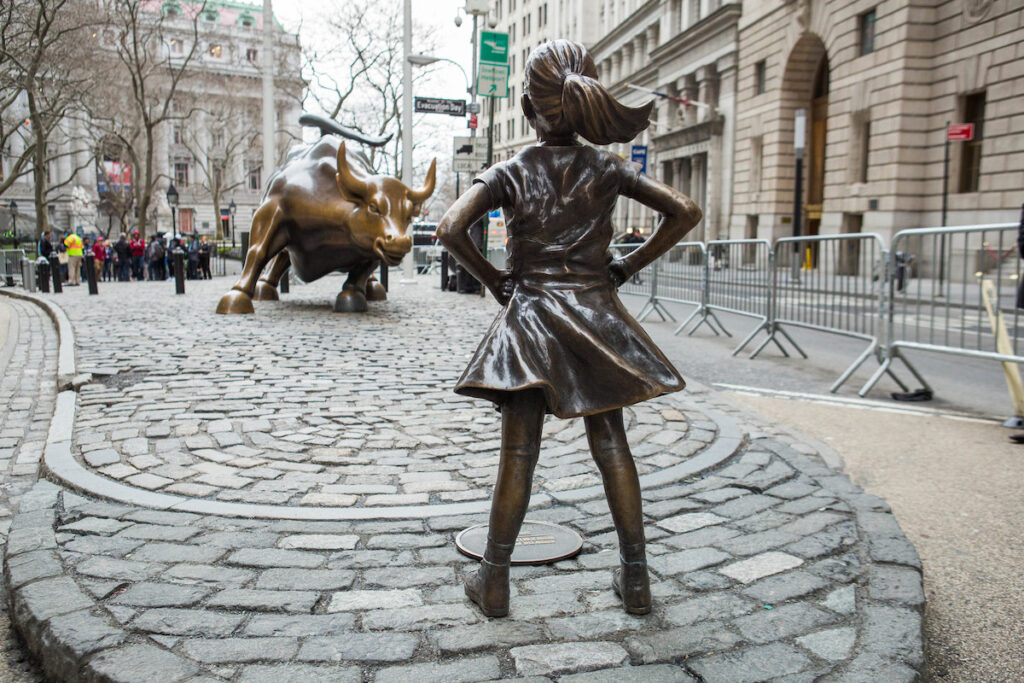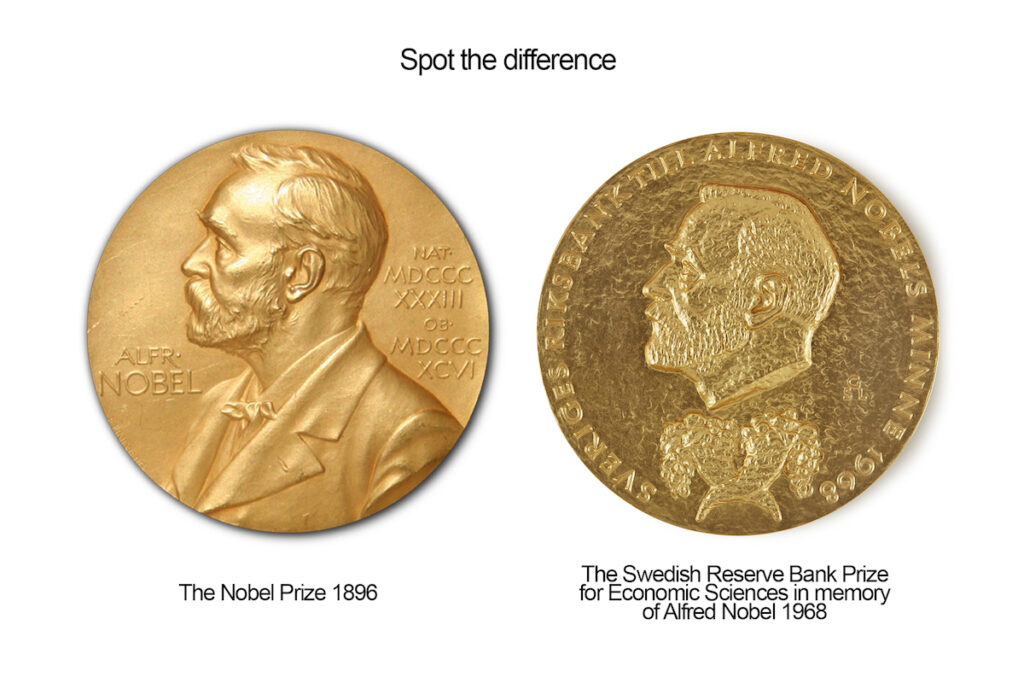
The last two decades in anthropology would have been dramatically less exciting without David Graeber. Given David’s prominent association with the Occupy rebellions and with the Western Left more generally, this is even true for the Western world at large. With the publication of his debt book (Graeber 2010) – also exactly a decade ago – as Keith Hart once said, David became the most famous anthropologist among the general public of our age, taking that long empty seat next to Margaret Mead (and Levi Strauss perhaps). With the launch of the ‘Society for Ethnographic Theory’, the HAU journal and the turn towards Open Access publishing, David, now world famous, once more stirred up anthropology as well as academia more broadly. It feels a bit weird to say this about an anthropologist of the gift, but David literally made history by attacking established centers and practices of power and wealth.
While some in this series of seminars knew him well as a direct colleague or friend, I only ran into David a couple of times. I felt it was not easy to get to know him. He seemed a bit solipsistic, drawn into conversation with himself, sometimes mumbling and laughing privately about the sudden insights he seemed to run into while doing so. If you had not been introduced to that intimate conversation before, it was not so easy to enter it, I felt. He and I never had the time to get to that point, for which I am sorry.
I remembered these few moments of mutual awkwardness while rereading Toward an Anthropological Theory of Value (Graeber 2001). Its style of writing reminded me of David’s internal conversations and his moments of private enjoyment. The narrative of this book meanders, feels sometimes elliptic (as it does in all his books). The flow of the argument regularly gets punctuated. Jolts of joyful energy seem to pull the author in multiple unexpected directions. The possible connections that emerge from the words that he happened to choose, seem to seduce him to leave the path and get into the bush around it. David, who celebrates creative freedom, is certainly the Zizek of anthropology. As with Zizek, things can become very detailed within a narrative that was already far from linear. As a reader you may feel you are being unduly slowed down, even taken advantage of. But David can also take you by the hand while making a reckless jump, allowing you for a moment to tower over a conceptual landscape where most people would normally be lost, and you are struck by the sudden clarity of perception. I now imagine that such apparently reckless jumps produced his moments of private enjoyment.
My discussion here of Toward an Anthropological Theory of Value must be short. I will leave the bush aside – the book has long chapters on gift giving societies in Melanesia, Madagascar and among Amerindians, some of it very interesting, some of it less compelling for non-specialists – and I will focus on the landscapes that emerge during those conceptual jumps. This book is not just representative of his writing style and his counterintuitive rhythm of discovery. It also partly lays out the tool kit of concepts, perspectives, and issues that was going to dominate his later work. In fact, it offers in embryo his full program of research. What is then David’s theory of value? How do Marx and Mauss cohabit in it? How do his very outspoken Chicago teachers, Marshall Sahlins and Terence Turner, figure? What are its possibilities and blind spots?
David developed his ‘anthropological theory of value’ against the intellectual and political background of what he calls ‘the bleak 1990s’. He is very explicit about it: neoliberal hegemony, globalized capitalism, economics as dominant social imaginary, post-structuralism, and the reduction of politics to ‘creative consumption’ and identity, both in anthropology and other social disciplines. While structure and history had gone out of fashion, he writes, action and agency had become cynically equated in social theory to mere individual market choices. Before 1989, Bourdieu had worked out ‘habitus’ as the connecting concept between structure and agency (and Giddens had been busy with similar issues). Graeber swiftly passes him by for the focus on dominance and power games that underlie Bourdieu’s project, in David’s eyes another symptom of the cynicism that he saw around him. For David, at this point in his career, it still seemed paradigmatic that anthropologists are dealing with people in relatively egalitarian societies and with people who desire (a core concept for him) to precisely escape such power games. David proposes ‘value’ as the point where structure and agency meet. After an interesting interlude on Roy Bashkar (and critical realism) and his thinking in terms of forces, tendencies, and processes rather than objects he emphasizes that his value does exactly that: setting open-ended dialectical processes in motion. What is this value and what are the anthropological traditions that help him shape it up?
The shortest way to answer that question is to bring in that concept that is all but foundational for David’s work: ‘constituent imagination’. While he borrows that term from Italian autonomous Marxism (Virno and Negri), he links it to a long anthropological pedigree that connects Klyde Kluckhohn, Marshall Sahlins, Terence Turner, Louis Dumont, and others, all of whom are discussed in interesting and original ways here. Value then emerges as what people tell themselves they find important in the realization of their lives, not very different from the common-sense meaning of value in various European languages. David’s value is emic, idealist, and dynamic. While his notion seems initially not very different from let’s say Talcott Parsons, David wouldn’t be Graeber if he didn’t loudly refuse the implied structural functionalism: David’s value emphatically doesn’t work to solidify stable social reproduction. On the contrary, it feeds the social imagination, both collectively and individually, and it is both agonistic and liberating. In the social processes that it sets in motion people die, strive, love, compete, believe, pray, moralize, estheticize, sacrifice, fetishize, and whatnot. Value is about making differences, and about ranking and proportioning them. De Saussure’s structuralism may be essential for how our language and imagination works, but David, following his teacher Terence Turner, adroitly embraces Vygotsky’s ‘generative structuralism’ and shifts the weight from langue to parole and towards ‘signifying material action’. Hence his interest in ethnohistory and the telling and remembering of histories. Stories become part of ‘constituent imagination’ in action, the practiced struggle for individual and collective autonomous becoming and in how these struggles are being remembered.
In the end he concedes that his foundational notion of value is perhaps not that different from Dumont, a student of Levi Strauss and the ultimate theorist of hierarchy, except for its emphasis on process, action, and agency. And while the structure of our social imagination is certainly ‘a totality’ of the Saussurian kind and as such fully embedded in the existing structuration of our societies, as well as fundamental for how we teach our children and reproduce ourselves, it is clear to David that this is a totality ridden by ambivalence and contradiction. There are inevitably contradictions between desires and pragmatic realities. ‘Constituent imagination’ often seems more the property, desire, and practice of individuals or groups and moieties within societies than of societies as a whole.
Where is Marcel Mauss here, David’s most basic theoretical and political inspiration? Mauss appears at all levels of David’s approach. David spends some very interesting pages introducing him as the key thinker for a non-cynical anthropology and for a humanist Left, who famously rejected the Bolsheviks for their recourse to state terror, authoritarianism, and bureaucratic diktat. In the book, Mauss of course appears as the quintessential theorist of the gift and of egalitarian societies, which, as I said, are for David at this point still the self-evident object of anthropology. David may criticize him for his romanticism, but he fully embraces his notion of ‘everyday communism’ as the glue of human sociality. Then there is also the basic methodological notion of the ‘total prestation’ where the full quality, the core values, of a whole society are reflected in each and every of its parts, including the imaginations and actions of its members. David does not discuss it explicitly, but if I’m not mistaken, he does seem to think that Mauss’ approach may be too static for his purposes. The constituent values for which people once congregated as a distinct group or society, may become corrupted over time and people seek repair, interpretations will differ, agonistic and liberating conflict will ensue. Holism, for David, therefore, does not take away the dialectics. On the contrary, it feeds them and is fed by them.
In all this Graeber seems to follow Terence Turner closely. And indeed, in a much later preface to a collection of Turner’s essays (2017) David remarked that he wrote his value book to make the notoriously complex texts of Turner understandable for a wider public. The book was thus originally intended as a gift to Turner.
But Turner was strong on Marx, indeed perhaps the most outspoken Marxist in the anthropology of the 1990s. And Marx was strong on totality and dialectics too, but of a less idealistic kind. David in this book sets a Turnerian Marx into a dynamic conversation with Mauss. How does that work out? A Marxist will immediately wonder how the thoroughly idealist concept of value as constitutive imagination that Graeber is on to will relate to Marx’s similarly dialectical but certainly not idealist conceptions of (use, exchange, and surplus) value. Most importantly, how does it relate to Marx’s ‘law of value’, which is Marx’s short formula for talking about the social relations of capitalist accumulation.
Graeber is sympathetic to the young Marx who wrote on behalf of the emancipation of humans from their self-constructed religious fetishes which he wanted them to begin to see as the mere products of their own powers of creative imagination rather than as the gods that they had to obey. This indeed corresponds perfectly to David’s own agenda as his long and interesting discussions of fetishism show. But the post 1848 Marx of capital and labor receives rather short shrift. David repeatedly complains about the ‘convoluted language’ of Marxists. He does not like the Marxian vocabularies and prefers for example to talk about ‘creative powers’ rather than about labor (a concept that hardly appears in this book on value). Marx for David is mainly interesting, he says, for his approach to money – and here we find an early announcement of the coming book on debt. So, not capital, not labor, but money. He emphasizes that for Marx value and money are not the same, but in the next pages Marx’s value disappears and David gets stuck with money and prices, which are of course a holistic system too. With Terence Turner, he embraces the idea that ‘socially necessary labor time’ – a core element of Marx’s ‘law of value’ – is also inevitably a cultural construct but the discussions about that centrally important concept for Marx are not referenced in this book as they are by Turner (2008). Nor does David seem aware that this concept helps Marx to discover a particular relational form of value under capitalism that consistently operates behind people’s back and is therefore ontologically something rather different than a self-conscious ‘constituent’ value choice. In Chicago David was apparently not exposed to Moishe Postone. He also does not seem aware of the important value debates among Marxist theorists of the 1970s (in particular Diane Elson 1979, whom Turner had read closely). Considering the number of pages dedicated to such discussions in this book, Marx’s value appears intellectually far less compelling then Kluckhohn’s, Parson’s or Dumont’s value. ‘Socially necessary labor time’ in David’s handling is then in the next moment reduced to a rather static cultural concept for determining, via prices, how important we find particular items of consumption as compared to other items of consumption (cars: 7% of yearly consumer expenditures in the US in the late nineties). David’s Marx, surprisingly, seems in the end not to be about capital and labor but primarily about consumption, not unlike the way David’s teacher Marshall Sahlins looked at capitalism in ‘Culture and Practical Reason’ (1976).
It is also as if David at once forgets about his discussion of Roy Bhaskar and his own declared embrace of forces, tendencies, and processes. ‘Socially necessary labor time’ in Marx is a dynamic dialectical relation between abstract capital and abstract labor that produces immanent tendencies and is indeed also a dynamic dialectical cultural construct. It is the basis for Marx’s ‘law of value’, which Marx knew well was not a law but a tendency. As labor does its daily work for capital, labor productivity would systematically be driven up because of the competition among capitals and of the class struggle with labor, via mechanization, automation, and the overall capitalization of life. Over time labor would lose any sovereignty over its own conditions of life and social reproduction. Apart from being disciplined in its wage claims and lifestyles, lest capital would move to cheaper and more hardworking places, labor would also be forced into (paying for) ever more education or face devaluation and degradation. And of course, it would have to face the inescapable uncertainties of life and status. The same would be true for cities, regions, and states that failed to compete within a globalizing capitalism and would therefore literally be up for grabs. All of this, including the geographically uneven and war-mongering repercussions, is a logical part of Marx’s ‘law of value’. David could have used Mauss and the gift to give a deeper anthropological and relational twist to Marx’s rather flat notion of use value. But Marx is never allowed in this book to play on his own unique strengths: in the end both capital and labor, the two elementary positions whose combination produces not just use values and exchange values but, crucially, surplus value, the very returns to capital that are the key driver of social change in a capitalist world, simply disappear. According to David Harvey (2018), Marx sees capital as ‘value on the move’. But in this book that sort of value is just moved out – only to be rediscovered big time and with ‘anarchist concreteness’ in David’s later work on debt and bullshit jobs.
Constituent imagination is David’s core concept. It was a concept that came from Italian Marxist post-operaismo authors who were impressed by labor’s refusal to work for capital in the Italy of the seventies and eighties after they had lost a series of violent confrontations. Young workers now preferred to seek the creation of autonomous worlds of life and labor outside the wage nexus. This is shortly mentioned by Graeber, and he imagines, like James Scott, that his egalitarian kinship groups similarly refused to further engage with hierarchical power centers and simply moved out to constitute their own desired societies inspired by constituent egalitarian imagination. Clearly, this is a further radicalization of the original concept, which talks about evading the wage nexus but does not carry any hint at a mass exodus out of Egypt towards a promised land and a new separate society, to use an image. David even argues that all societies at some point were formed out of such mass rejection of earlier power centers and were therefore always founded on constituent imagination. This to me seems like an extravagant claim, largely untestable, and suspiciously supportive of David’s theoretical purposes. However, Italian Marxists such as Antonio Negri always kept the development of capital and the state in dynamic tension with the autonomous desires of his multitudes, which were indeed urban subjects rather than spread out kin-groups in marginal spaces. In Graeber’s Value book that dynamic tension disappears. David’s egalitarians are on their own, engaging in a similar constitutive mytho-praxis that has inspired Marshall Sahlins’s work (see also Jonathan Parry’s discussion of Lost People for a similar disappearance of the IMF and therefore of global capital in David’s analysis of recent Malagasy histories).

David in this book firmly dismisses Appadurai’s ‘regimes of value’ notion (1986) for his neoliberal fixation on consumption. Appadurai recently returned the compliment by claiming that David’s anthropology was an entirely traditional one. David did a fantastic job in giving 21st century anthropology a new pride in focusing on egalitarian desires and popular values of autonomy in rejection of the rule of capital. But Appadurai is unfortunately right in one way: the values David envisions are emic, singular, particular, idealist, and deeply place-based and return us to classic bounded fieldwork and a bounded notion of culture. The book has no references to Wolf, Wallerstein, or anyone else dealing with space and multiscalar dynamic analysis of the dialectical value processes associated with globalized capital and the ensuing popular counter politics and desires. Except for a journalistic type of political economy, there is in fact hardly any serious political economy at all here, not even an anthropological political economy – a school that traces itself back to leading scholars like Wolf, Mintz, and Leacock, always largely ignored by both Graeber and Sahlins. David later improved marvelously on that lack with the Debt book (but see for example Kalb 2014), which, importantly, also brought long run and deep global histories back into anthropology. But while that book appears to have been incubated during the writing of this text on value via David’s interest in Marx and money, it is not yet conceptually or methodologically anticipated, and I do wonder how David later looked back on this very traditional anthropological theory of value he develops here.
David was a magnificent and creative utopian and moralist. He was uniquely in tune with the resistant Western mood of the times, from the alter-globalists to Occupy, including in his embrace of the ethos of the mass refusals and moral outcries that we have seen in the last twenty years, often driven by the desire for autonomy and the condemnation of the overall bleakness of things. But he did not at all anticipate the rise of the populist right, which is also very much about value and values, and indeed loudly proclaims a desire for the resurrection of (white, male, majoritarian etc.) hierarchy (see Kalb 2021 for further discussion). The rise of the right in many places after the failed rebellions of 2011 must be understood from within the failures of the ‘horizontalist’ mobilizations of which David and many of us were a part and which at that point seemed to have an elective affinity with the anthropology of egalitarianism. Nor does David’s book on value anticipate a situation where core central bankers and enlightened economists write books about the economics of the green transition with ‘value’ prominently in the title while making a claim to the heritage of the value-driven popular risings that David sees himself part of (Carney 2020; Mazzucato 2019). And finally, in the excitement of retrieving some pride for the traditions of the discipline, in David’s book on value we also seem to have forgotten some of the earlier advances in ‘the anthropology of complex societies’ and of ‘world society’, including some Marxist ones which are very precisely about value.
Don Kalb is founding editor of Focaal and FocaalBlog and a professor of social anthropology at the University of Bergen, where he leads the ‘Frontlines of Value’ project.
This text was presented at David Graeber LSE Tribute Seminar on ‘Value’ .
References
Appadurai, Arjun. 1986. “Introduction: commodities and the politics of value” In The Social Life of Things: Commodities in Cultural Perspective, edited by Arjun Appadurai, 3-36. Cambridge: Cambridge University Press.
Carney, Marc. 2020. Value(s): Building a better world for all. William Collins: Dublin.
Elson, Diane. 2015 (1979). Value: The Representation of Labour in Capitalism. London: Verso
Graeber, David. 2001. Toward an anthropological theory of value: the false coin of our own dreams. New York: Palgrave.
Graeber, David. 2010. Debt: the first 5,000 years. Brooklyn, N.Y.: Melville House.
Harvey, David. 2018. Marx, Capital and the Madness of Economic Reason. London: Profile books
Kalb, Don. 2014. “Mavericks: Harvey, Graeber, and the reunification of anarchism and Marxism in world anthropology.“ Focaal 69: 113-134.
Kalb, Don. 2021. “The neo-nationalist ascendancy: further thoughts on class, value and the return of the repressed.” Social Anthropology 29 (2): 316-328.
Mazzucato, Mariana. 2019. The Value of Everything: Making and Taking in the Global Economy. London: Penguin.
Sahlins, Marshall. 1976. Culture and practical reason. Chicago: University of Chicago Press.
Terence Turner. 2008. “Marxian Value Theory: An Anthropological Perspective.” Anthropological Theory 8 (1): 43-56.
Turner, Terence. 2017. The Fire of the Jaguar. Chicago: HAU Books.
Cite as: Kalb, Don. 2021. “Constituent Imagination versus the Law of Value: On David Graeber’s ‘Anthropological Theory of Value’.” FocaalBlog, 13 December. https://www.focaalblog.com/2021/12/13/don-kalb-constituent-imagination-versus-the-law-of-value-on-david-graebers-anthropological-theory-of-value.

